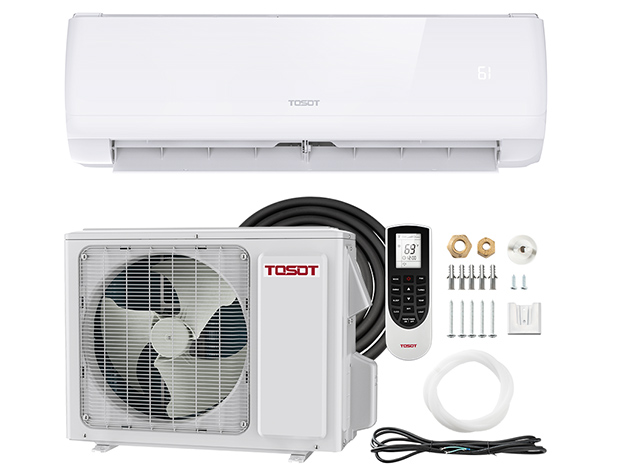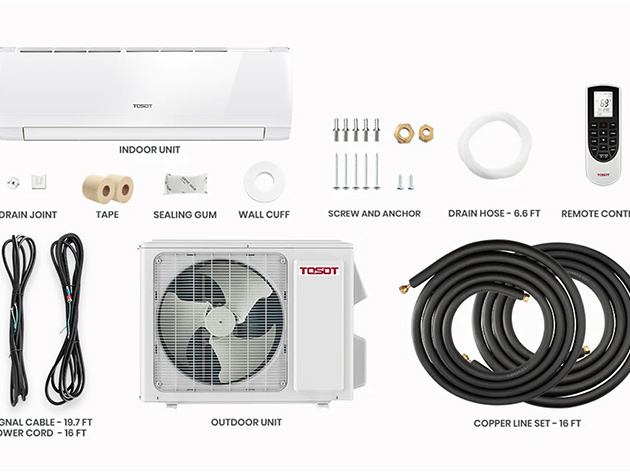Mini Split Heat Pump And Air Conditioner

Mini-split heat pump and air conditioner systems are gaining popularity as efficient and versatile solutions for heating and cooling homes and businesses. They offer a compelling alternative to traditional central air conditioning and heating systems, especially for spaces where ductwork is impractical or unavailable. This guide provides a comprehensive overview of mini-split systems, covering their components, operation, benefits, drawbacks, installation, and maintenance.
What is a Mini-Split System?
A mini-split system, also known as a ductless mini-split, is a type of heating and cooling system that does not require ductwork to distribute air. Instead, it uses a compact outdoor unit connected to one or more indoor units via refrigerant lines and electrical wiring. Think of it as a localized heating and cooling solution for specific areas or zones.
Key Components:
- Outdoor Unit (Compressor/Condenser): This unit houses the compressor, condenser coil, and fan. It's responsible for either rejecting heat (in cooling mode) or absorbing heat (in heating mode). Essentially, it's the engine of the system.
- Indoor Unit (Air Handler): Mounted on a wall, ceiling, or floor, this unit contains the evaporator coil, fan, and air filter. It's what you see inside the room and is responsible for blowing conditioned air into the space. It's like the "air dispenser."
- Refrigerant Lines: These copper pipes carry the refrigerant between the outdoor and indoor units. Think of refrigerant as the "blood" of the AC system, carrying heat from inside to outside (in cooling mode) or outside to inside (in heating mode).
- Electrical Wiring: Provides power to the units and allows for communication between them.
- Condensate Drain: Removes condensation produced during the cooling process.
- Remote Control: Used to control the temperature, fan speed, and other settings. Many modern units can also be controlled via smartphone apps.
How Does a Mini-Split System Work?
Mini-split systems operate on the same principles as traditional air conditioners and heat pumps, but without the need for ductwork. The key is the refrigerant cycle. Here's a breakdown:
Cooling Mode:
- Refrigerant Absorbs Heat: The refrigerant, in a gaseous state, flows from the outdoor unit to the indoor unit. Inside the indoor unit's evaporator coil, the refrigerant absorbs heat from the room air, causing it to evaporate and cool the air.
- Cooled Air Circulates: The indoor unit's fan blows the cooled air back into the room, lowering the temperature.
- Refrigerant Returns Outdoors: The now-heated refrigerant gas travels back to the outdoor unit.
- Heat is Released: In the outdoor unit's condenser coil, the refrigerant releases the absorbed heat to the outside air, converting back into a liquid state. The fan helps to dissipate this heat.
- The Cycle Repeats: The liquid refrigerant then flows back to the indoor unit, and the cycle begins again.
Heating Mode (Heat Pump):
A heat pump works in reverse to provide heating. It extracts heat from the outside air (even in cold temperatures, there's still some heat energy present) and transfers it indoors. This process involves the same refrigerant cycle, but with the flow of refrigerant reversed.
- Refrigerant Absorbs Heat (from Outside): The refrigerant absorbs heat from the outside air in the outdoor unit's evaporator coil, even when it's cold outside.
- Refrigerant is Compressed: The refrigerant is compressed in the outdoor unit, increasing its temperature.
- Heat is Released (Indoors): The hot refrigerant gas flows to the indoor unit's condenser coil, where it releases heat into the room air.
- Cooled Refrigerant Returns Outdoors: The cooled refrigerant travels back to the outdoor unit, and the cycle repeats.
It's important to note that the efficiency of a heat pump decreases as the outdoor temperature drops. In very cold climates, supplemental heating may be needed.
Benefits of Mini-Split Systems:
- Energy Efficiency: Mini-splits are generally more energy-efficient than traditional central air systems because they don't suffer from duct losses (air leaks in ductwork). They often have high SEER (Seasonal Energy Efficiency Ratio) and HSPF (Heating Seasonal Performance Factor) ratings.
- Zoned Cooling and Heating: You can control the temperature in individual rooms or zones, allowing you to heat or cool only the areas you're using. This saves energy and improves comfort. Imagine only heating your bedroom at night, instead of the entire house.
- Easy Installation: Installation is typically less invasive and less expensive than installing ductwork for a central air system. A small hole is needed in the wall to run the refrigerant lines and electrical wiring.
- Quiet Operation: Mini-split systems are known for their quiet operation, both indoors and outdoors. The compressor is located outside, minimizing noise inside the living space.
- Improved Air Quality: Many mini-split systems come with advanced air filtration systems that can remove dust, pollen, and other allergens from the air.
- Flexibility: They can be installed in a variety of locations, including homes without existing ductwork, additions, sunrooms, and garages.
Drawbacks of Mini-Split Systems:
- Initial Cost: The initial cost of a mini-split system can be higher than a window AC unit, although often competitive with central AC when installation of ductwork is factored in.
- Aesthetics: Some people find the appearance of the indoor units to be less aesthetically pleasing than traditional vents. However, modern designs are becoming more sleek and discreet.
- Installation Complexity: While generally easier than installing ductwork, installation still requires professional expertise to ensure proper refrigerant line connections, electrical wiring, and system performance.
- Maintenance: Regular maintenance, including filter cleaning and coil cleaning, is essential to maintain optimal performance and efficiency.
- Limited Heating Capacity in Extreme Cold: Heat pumps become less efficient in very cold climates, and supplemental heating may be required.
Choosing the Right Mini-Split System:
Selecting the right mini-split system depends on several factors, including:
- Size of the Space: The BTU (British Thermal Units) rating of the system should match the size of the area you need to heat or cool. A larger space requires a higher BTU rating.
- Climate: Consider the climate in your area. If you live in a very cold climate, you may need a system designed for low-temperature operation or a supplemental heating source.
- Number of Zones: Determine how many zones you want to control independently. Multi-zone systems can connect multiple indoor units to a single outdoor unit.
- Energy Efficiency Ratings: Look for systems with high SEER and HSPF ratings to maximize energy savings.
- Features: Consider features such as programmable thermostats, sleep mode, and air purification systems.
- Budget: Set a budget and compare prices from different manufacturers and installers.
Installation:
Professional installation is highly recommended for mini-split systems. A qualified HVAC technician will ensure that the system is properly sized, installed, and charged with refrigerant. Improper installation can lead to performance issues, reduced efficiency, and potential safety hazards.
The installation process typically involves:
- Mounting the Outdoor Unit: The outdoor unit is typically mounted on a concrete pad or wall bracket.
- Mounting the Indoor Unit(s): The indoor unit(s) are mounted on a wall, ceiling, or floor, depending on the model.
- Connecting Refrigerant Lines and Electrical Wiring: The refrigerant lines and electrical wiring are run between the outdoor and indoor units through a small hole in the wall.
- Vacuuming the Refrigerant Lines: The refrigerant lines are vacuumed to remove air and moisture.
- Charging the System with Refrigerant: The system is charged with the correct amount of refrigerant.
- Testing the System: The system is tested to ensure proper operation.
Maintenance:
Regular maintenance is crucial for maintaining the efficiency and longevity of your mini-split system.
- Clean Air Filters: Clean or replace the air filters every one to three months. Dirty filters restrict airflow and reduce efficiency.
- Clean the Indoor and Outdoor Coils: Clean the indoor and outdoor coils at least once a year. Dirty coils reduce heat transfer. A professional HVAC technician can perform this service.
- Check Refrigerant Levels: Have a professional check the refrigerant levels periodically. Low refrigerant levels can indicate a leak and reduce efficiency.
- Inspect the Condensate Drain: Ensure that the condensate drain is clear and free of obstructions. A clogged drain can cause water damage.
- Schedule Professional Maintenance: Schedule annual maintenance with a qualified HVAC technician to ensure that the system is operating properly.
Cost Considerations:
The cost of a mini-split system can vary depending on several factors, including:
- System Size (BTU Rating): Larger systems with higher BTU ratings will cost more.
- Number of Zones: Multi-zone systems will cost more than single-zone systems.
- Energy Efficiency Rating (SEER and HSPF): Systems with higher energy efficiency ratings will typically cost more upfront but can save you money on energy bills in the long run.
- Brand: Different brands offer different features and price points.
- Installation Costs: Installation costs can vary depending on the complexity of the installation and the location.
Be sure to get quotes from multiple installers to compare prices and services.
Conclusion:
Mini-split heat pump and air conditioner systems offer a compelling solution for heating and cooling homes and businesses, particularly in situations where ductwork is not feasible or desirable. They provide energy efficiency, zoned comfort, easy installation, and quiet operation. While the initial cost may be higher than some alternatives, the long-term benefits in terms of energy savings and comfort can make them a worthwhile investment. By understanding the key components, operation, benefits, and drawbacks of mini-split systems, you can make an informed decision about whether they are the right choice for your needs. Remember to consult with qualified HVAC professionals to determine the appropriate system size and ensure proper installation and maintenance.










